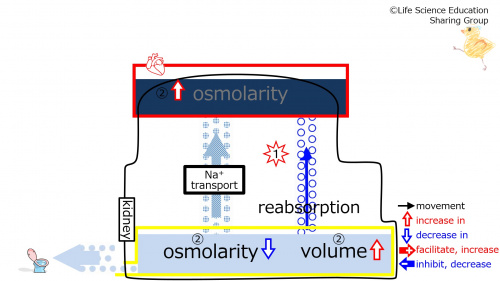「SHolroydAtWeilCornellMedQatar/Urology/Kidney/Tubules/WaterReabsorption/EffectOfDecrease」の版間の差分
編集の要約なし |
編集の要約なし |
||
| 5行目: | 5行目: | ||
<div class="avoid-page-break"> | <div class="avoid-page-break"> | ||
[[ファイル:WaterReabsorptionBaseLine-Eng.jpg|left|500px]] | [[ファイル:WaterReabsorptionBaseLine-Eng.jpg|left|500px]] | ||
<!-- | |||
[[メディア:WaterReabsorptionBaseLine-Eng.mp4|video prior to the decrease in vasopressin (ADH)]]<br> | [[メディア:WaterReabsorptionBaseLine-Eng.mp4|video prior to the decrease in vasopressin (ADH)]]<br> | ||
--> | |||
Prior to vasopressin (ADH) decreasing (at baseline), we will make the assumption that the subject is in homeostasis with normal plasma and urine osmolarities (isotonic) and volumes. | Prior to vasopressin (ADH) decreasing (at baseline), we will make the assumption that the subject is in homeostasis with normal plasma and urine osmolarities (isotonic) and volumes. | ||
<br style="clear:both;" /> | <br style="clear:both;" /> | ||
| 12行目: | 14行目: | ||
<div class="avoid-page-break"> | <div class="avoid-page-break"> | ||
[[ファイル:WaterReabsorptionEffectOfDecrease-2Eng.jpg|left|500px]] | [[ファイル:WaterReabsorptionEffectOfDecrease-2Eng.jpg|left|500px]] | ||
<!-- | |||
[[メディア:WaterReabsorptionEffectOfDecrease-2Eng.mp4|video just after the decrease in vasopressin (ADH)]]<br> | [[メディア:WaterReabsorptionEffectOfDecrease-2Eng.mp4|video just after the decrease in vasopressin (ADH)]]<br> | ||
--> | |||
Step 1: Suppose that the synthesis, secretion, and blood concentration of vasopressin (ADH) decreases.<br> | Step 1: Suppose that the synthesis, secretion, and blood concentration of vasopressin (ADH) decreases.<br> | ||
Step 2: The water channel-increasing effect of vasopressin (ADH) decreases, thereby decreasing the number of water channels. This decreases the reabsorption of water by the kidney. | Step 2: The water channel-increasing effect of vasopressin (ADH) decreases, thereby decreasing the number of water channels. This decreases the reabsorption of water by the kidney. | ||
| 19行目: | 23行目: | ||
<div class="avoid-page-break"> | <div class="avoid-page-break"> | ||
[[ファイル:WaterReabsorptionEffectOfDecrease-3Eng.jpg|left|500px]] | [[ファイル:WaterReabsorptionEffectOfDecrease-3Eng.jpg|left|500px]] | ||
<!-- | |||
[[メディア:WaterReabsorptionEffectOfDecrease-3Eng.mp4|video showing the changes in plasma and urine after the decrease in vasopressin (ADH)]]<br> | [[メディア:WaterReabsorptionEffectOfDecrease-3Eng.mp4|video showing the changes in plasma and urine after the decrease in vasopressin (ADH)]]<br> | ||
--> | |||
Step 3: The ratio of Na<sup>+</sup> to water entering the plasma due to reabsorption increases. This increases plasma osmolarity (hypertonic). Because a higher ratio of Na<sup>+</sup> to water leaves the tubule due to reabsorption, the fluid remaining in the tubule has a lower osmolarity (hypotonic). Also, with a decrease in water reabsorption, there is more water remaining in the tubule. Overall, the urine becomes less concentrated (hypotonic) and higher in volume. | Step 3: The ratio of Na<sup>+</sup> to water entering the plasma due to reabsorption increases. This increases plasma osmolarity (hypertonic). Because a higher ratio of Na<sup>+</sup> to water leaves the tubule due to reabsorption, the fluid remaining in the tubule has a lower osmolarity (hypotonic). Also, with a decrease in water reabsorption, there is more water remaining in the tubule. Overall, the urine becomes less concentrated (hypotonic) and higher in volume. | ||
<br style="clear:both;" /> | <br style="clear:both;" /> | ||
2020年2月13日 (木) 14:38時点における版
| With the decrease in the synthesis, secretion, and blood concentration of vasopressin (anti-diuretic hormone, ADH), the number of water channels decreases . |
Prior to vasopressin (ADH) decreasing (at baseline), we will make the assumption that the subject is in homeostasis with normal plasma and urine osmolarities (isotonic) and volumes.
Step 1: Suppose that the synthesis, secretion, and blood concentration of vasopressin (ADH) decreases.
Step 2: The water channel-increasing effect of vasopressin (ADH) decreases, thereby decreasing the number of water channels. This decreases the reabsorption of water by the kidney.
Step 3: The ratio of Na+ to water entering the plasma due to reabsorption increases. This increases plasma osmolarity (hypertonic). Because a higher ratio of Na+ to water leaves the tubule due to reabsorption, the fluid remaining in the tubule has a lower osmolarity (hypotonic). Also, with a decrease in water reabsorption, there is more water remaining in the tubule. Overall, the urine becomes less concentrated (hypotonic) and higher in volume.
Challenge Quiz
With a decrease in the synthesis, secretion, and blood concentration of vasopressin (anti-diuretic hormone, ADH), the number of water channels in the kidney increases decreases .
With a decrease in the synthesis, secretion, and blood concentration of vasopressin (anti-diuretic hormone, ADH), water reabsorption by the kidney increases decreases .
With a decrease in the synthesis, secretion, and blood concentration of vasopressin (anti-diuretic hormone, ADH), urine volume increases decreases .
With a decrease in the synthesis, secretion, and blood concentration of vasopressin (anti-diuretic hormone, ADH), urine osmolarity increases decreases .
With a decrease in the synthesis, secretion, and blood concentration of vasopressin (anti-diuretic hormone, ADH), plasma osmolarity increases decreases .
The effect of decreasing in vasopressin (anti-diuretic hormone, ADH) is to contract female genital smooth muscle increase plasma osmolarity .
The effect of decreasing in vasopressin (anti-diuretic hormone, ADH) is to increase decrease the plasma osmolarity .



